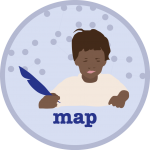Map
Part of these packages: Explore and create
Supported by these technologies:
Teams analyse their findings using mind-mapping techniques. They identify relations, similarities and differences between the examples and/or media files they collected. Based on their collected information and analysis, the teams refine their design brief, especially the design challenges, design results and audience. Then the teams record a reflection. Open ended questions can be challenging for students to answer initially. However, after passing the initial threshold, students are likely to have inspiring ideas. Classroom time: Approximately 1 lesson
1. Prepare / Listen
- Listen carefully to the student comments, and shape the activity according to their needs and interests.
- Expand your competence and expertise, by exploring digital mind-mapping tools and ensuing students can easily add their media files to the tool.
- Arrange pens, paper, post-it notes, tape, scissors and glue. Set up the space by arranging walls or large papers for students to group and stick their paper notes on.
2. Inspire
- Engage in a pedagogically meaningful conversation with the students about the data they collected: What did they collect, and how is the information meaningful for their project?
- For easy access, ask the students to move all of their information and data into one location and share it with everyone.
3. Coach / Question / Support
- Students write all information and data in the form of headlines, short sentences or figures on post-it notes or small pieces of paper, and group their notes. Alternatively they may use the digital mind-mapping tool you set up. Coach them how to best represent some of their findings by drawing the initial notes or making supportive suggestions.
- Support the teams to visually present relationships between the notes when grouping the data, for example, by drawing lines between information, placing notes hierarchically, or other spatial arrangements.
- View and discuss the relations with the students. Ask open ended questions to challenge their assumptions, for example, (a) what are the similarities and differences between the examples they found? (b) What additional challenges can you recognize?; (c) what would you like to adopt or try out? (d) what would make your design unique? (e) Does the design brief need refinement? How does it need to be refined?; (f) How does the exploration relate to the design? (g) What design decisions would result from the exploration? (f) What are emerging project ideas?
- A more full-body involvement of mapping ideas can be achieved through spatial grouping of ideas and collected information. This can might support learners to focus, as they can stretch their arms to place a post-it note to a specific location dedicated to e.g. challenges
- Teams list identified similarities and differences, and update their design briefs, particularly in relation to design challenges, design results and audience.
- They document their findings on their blog, including sketches of emerging project ideas and record a reflection. You can record a reflection for each team providing feedback and evaluative comments to each student work. Their reflections can be used for assessment and for staying focussed on the task.
4. Assess
- Review the work of each team, their reflection recordings and blog entries, to ensure everyone explored and collected examples and/or media files. Then record audiovisual feedback for them. Your feedback might include suggestions and questions about how successful the technique was implemented, how it could be used for future projects, and how it could be done better next time.
- You could assess the teams’ ability to identify design challenges, to draw relationships between observations and examples
- You could also ask the students to grade their teammates’ contributions, using the student grades to help form your own assessment.
This post is also available in: Spanish Hungarian Turkish











